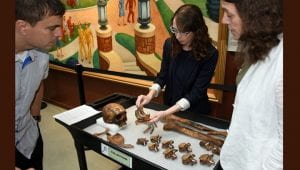In 1990, local children in Griswold, Connecticut, USA, accidentally uncovered the bones of a peculiar set of graves dating back to the 19th century. Amongst these remains, one skeleton – that bore the marker “JB55” – stood out. The skeleton was arranged in a skull and crossbones formation which signified that whoever had buried the deceased believed them to be a vampire. This symbol was traditionally used to stop vampires from rising from the dead to prey upon the living, but what exactly is the story of this “Connecticut Vampire”?

In order to resolve the mystery of the Connecticut Vampire’s identity, forensic scientists made use of genetic markers. Genetic markers are lengths of DNA with a known position on the chromosome that can be used to identify individuals. These DNA segments are often repeating sequences called microsatellites which vary in the number of repeats between individuals in a population. It is this unique variation and their heritability that allows them to be used as a distinguishing tool and a method to determine common ancestry.
In the case of the Connecticut Vampire, Y chromosomal DNA from the remains were analysed and genetic markers were identified. This information was cross referenced to online genealogy databases in an attempt to locate a living ancestor. A family with the surname “Barber” was the closest match which prompted investigators to look for the name in local newspapers. In 1826 there was a notice of death for John Barber and his son Nathan Barber. This seemed to explain the grave marking “JB55” and the presence of a child’s grave nearby marked “NB13”.
Further analysis of John Barber’s bones indicated that he had had tuberculosis; the symptoms of which could have resembled vampirism, symptoms such as a bloody cough, night sweats, weight loss, and jaundice. These symptoms might have led the local community to start rumours of vampirism. As tuberculosis is contagious and might spread to close contacts, to family members in particular, this could easily have been seen as damning evidence of a vampire converting others.
This is far from an isolated incident. Tuberculosis was fairly rampant in New England in the 19th century, and it was treated with a fair amount of romanticism. Folklore of vampirism was born out of the epidemic, likely due to the lack of scientific understanding of the illness and of how diseases spread in general. This, coupled with the rural nature of New England communities would have helped the spread of these superstitions and rituals. In fact, this romantic era of vampirism derived from cases of tuberculosis may have inspired Bram Stroker’s Dracula.
As shown by their use in the case of John Barber, genetic markers are a useful new tool that have been added to the arsenal of forensic scientists. Long gone are the days of Sherlock Holmes, with his magnifying glass and deerstalker. Nowadays the identity of killers and criminals can be determined by looking for particular sequences. Even the FBI utilise a set 13 microsatellite loci to identify the unique genetic makeup of suspects.
While this concept of DNA fingerprinting has been around for a while, in recent years, refining technology to improve its efficiency and allow degraded genetic samples to be used. This has opened up the possibility to use increasingly old samples – like 19th century bones – in analysis. Moreover, due to the technology becoming cheaper, DNA profiling is more widely available than ever. There are online databases full of family histories. In the case of the Connecticut Vampire, it was this extensive information that allowed for connections to be made between the “JB55” label and the name John Barber. Building such large genealogical information banks can provide insights into history that were previously inaccessible.
DNA profiling is so common that nowadays you can have your own DNA analysed by for-profit companies like 23andMe or ancestryDNA. All you have to do is simply spit in a test tube and send it off for your genetic markers to be identified and processed into information regarding your genetic ancestry and makeup. This opens up a whole new debate on the reliability of information based just on genetic markers and the ethicality of it all – but that’s a topic of conversation all within itself.

